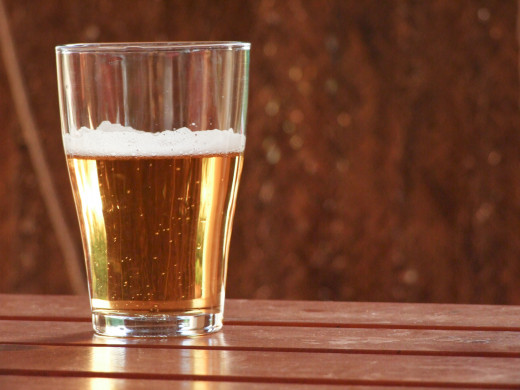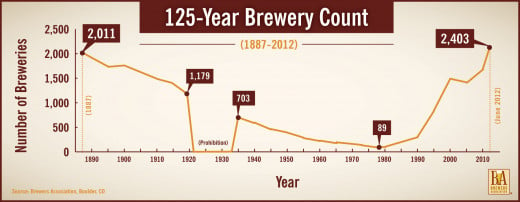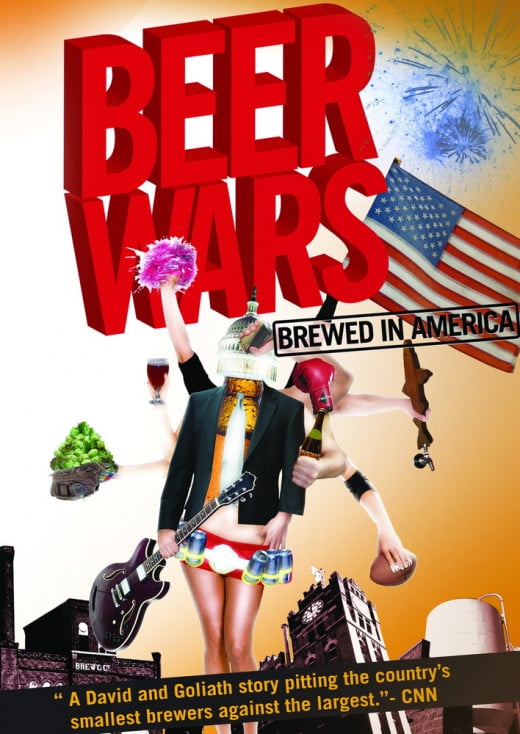What is Craft Beer?

Craft - the new industry buzzword
People that are around beer or beer lovers will hear a lot about craft beer and craft breweries, but what is it all about? The term "craft beer" carries with it a lot more implied meaning than it does formal meaning. First, though, we'll nail down that technical definition. We'll defer to the most prominent trade group in the United States, the Brewers Association, for our definition.
The current size limitation is 6 million barrels of beer or less, per year. This is actually a lot of beer and this limit keeps being stretched to keep one of craft beer's most prominent voices, Boston Beer Company (maker of Samuel Adams), in the fold. Most craft breweries make far, far less. For comparison's sake, though, Anheuser-Busch InBeverage (makers of Budweiser and most everything else other than MillerCoors holdings) makes hundreds of millions of barrels per year.
Craft breweries must also be independent, which means no more than 25% of the company can be owned by an alcohol-selling corporation that is not itself a craft brewer. In other words, you cannot be a craft brewery if you are owned by MillerCoors, but you can be if you are owned by Samuel Adams. There are not many examples of craft brewers owned by other craft brewers.
There is a final requirement for the products to be traditional in that the brewery sells a flagship beer that is all malt (barley is the only grain, not corn or other cheaper, relatively flavorless adjuncts) or sells at least 50% of its volume in beers that are all malt. A flagship beer is the beer a given brewery makes the most of. For example, New Belgium's flagship beer is Fat Tire and Boston Beer's flagship is Samuel Adams Boston Lager.
So those are the technical guidelines. Craft beer aficionados wouldn't necessarily define craft beer in this way though, so we still have some more work to do.

American Roots: Homebrewing Legalization H.R. 1337, Number 3534
Before Prohibition began in 1920, there were thousands of breweries in the United States, as high as 2,269 in 1887. By the time it was repealed in 1933, not many stayed afloat and even with legalization in place, even more began closing and selling out to bigger brewers. Some of this was propelled by many counties remaining "dry," effectively running local breweries out of business. The number of breweries was 331 upon repeal, rising to 857 in 1941, and then went on a steady decline to a paltry 44 in 1979. The major brewers, particularly Anheuser-Busch as well as Miller and Coors, grew so much that there was little market left for others. They bought out other brewers and took control of much of the distribution system, making it very difficult to stay open as an independent brewery.
Then, in 1979, H.R. 1337, Amendment 3534 took effect. An unintended consequence of 21st Amendment, which repealed Prohibition, was that its wording disallowed homebrewing. Many years later, finally, Jimmy Carter enacted this legislation which allowed any adult to brew 100 gallons of beer per year for himself without officially declaring himself or herself a business. This started a trend of many people taking up homebrewing as a hobby, brewing their own alternatives to what was commercially available (almost solely adjunct lagers). Many of these brewers that were originally experimenting in their own homes began to open up breweries, leading to what Americans call the "craft beer revolution." This led to a huge amount of new beer styles flooding the market, most notably an American take on the India Pale Ale; I outline this styling quite a bit more in my Pale Ale Style Guide.
The amount of breweries in the United States slowly grew after this for about ten years, up to 244 by 1989. At this point, with more than 10 years of legalized homebrewing and more craft breweries opening up, making money, and making unique, tasty beers, craft brewing exploded. By the year 2000, there were 1,493 breweries in the United States. In the year 2012, there were 2,751 breweries, the highest amount in American history. Many expect this bubble to burst at some point, but for now a good craft brewer can open up and stay afloat with relative ease.
To explore more historical beer data, check out the Beer Institute.

Learn more about beer!
I believe the Oxford Companion to Beer is perhaps the best do-it-all volume to learn about all subjects related to beer. I have consulted it extensively in creating this page.
British Roots: Homebrewing Legalization and the Campaign for Real Ale (CAMRA)
The first debt craft beer owes to the British goes far back in British brewing tradition, because old British recipes were among the most popular for early homebrewers and microbreweries. As I describe in more detail in the Pale Ale Style Guide, British ales were the perfect styles to showcase American ingredients. The British-style ales are still among the most popular styles for craft brewers; almost every brewery will have an IPA as well as a darker colored ale, for instance.
Moving on, the legalization of homebrewing in the UK is of importance. This happened on the heels of the legalization of home winemaking in 1959, and the winemakers trade group banded together with potential brewers and managed to successfully push for change in 1963. Unlike in the United States, though, homebrewing did not immediately result in well-crafted beers. For a long time, homebrewing was associated with cheap, inconsistent beer. It eventually took off in the 1990s with better beers, but it never became such a widespread commercial phenomenon as it had in the USA.
The Campaign for Real Ale (CAMRA), was started in 1971 by some Englishmen who were dissatisfied by England's reputation for low-quality beers; they knew that England's brewing history was far richer than the current offerings. The term "real ale" refers to cask-conditioned beers as opposed to force-carbonated beers. This means that real ales are carbonated from live yeast in the keg or bottle it is served from, not directly applied CO2 from the keg's nozzle. More scientific research has found that force carbonation does not necessarily sully flavor. Rather, force carbonation just happened to be employed more often by brewers that were cutting corners in other ways as well. Likewise, only a serious, crafty brewer would use cask conditioning. Nonetheless, this organization has successfully pushed for improved beer quality, despite a fairly significant dogmatic issue.
To learn more about this conflict, check out...

Macrobrewers vs. Craft Brewers
Much of the implied meaning that goes along with the term "craft" is its opposition to so-called "macrobrewers," namely Anheuser-Busch InBeverage and MillerCoors. There are other macrobrewers, such as Heineken International, but their market share in the American context is signficantly less. In 2012, A-B InBev and MillerCoors combined for a 74% market share in the United States. Also, American beer laws require that breweries do not sell directly to retailers; instead, a middle man wholesaler buys from brewers and then sells to retailers, which includes even arranging alcohol displays in individual retailers. Unfortunately, the two major macrobrewers also own an even larger portion of wholesalers than their market share. This means that independent brewers have to be distributed by their competitors in many markets, though independent wholesalers will coexist with corporate wholesalers in certain markets.
There is a marked difference in product type as well. By and large, macrobrewers market what are known to beer aficionados as "adjunct lagers." This refers to the lager yeast used (see my Ales vs. Lagers Hub for more info on that) and the adjunct grains used in place of barley. They use corn to lighten the flavor and lighten the body of the beer, which is a big no-no among traditionalists. In Germany, seen by many as the pinnacle of beer culture, it is illegal to use ingredients other than water, yeast, barley, and hops (occasionally wheat is okay for special beer styles like the Hefeweizen). Adjunct lagers generally have very little hop bitterness and little to no malt flavor with high carbonation and a light body, all of which seem to aim more for refreshment than flavor complexity. Light beers are even worse on this scale, since they are oftentimes basically cut with water to lower the calories. Those who are accustomed to adjunct lagers often have a difficult time tolerating other beer styles because they come off as extremely bitter or malty compared to the less flavorful adjunct lager.
Very few, if any, craft brewers make adjunct lagers. It is seen as a positive to brew different beer styles and brew flavorful, palate-challenging beers in the craft world. These types of beers are great beer aficionados, but often alienate those who started on adjunct lagers and want to try something new. Some speculate that the market potential of craft beer is limited in the long term for this reason. At this point in time, craft beer has risen to a 6% market share, which is a huge improvement but pales in comparison to the two largest brewers. Craft brewers have found a large, significant audience, but have had trouble converting people that have spent years drinking macrobrewery products. In recent years, macrobrewers have created brands that are meant to exude "craft," like Blue Moon, Shock Top, and others. These almost-craft brands do typically make beer styles other than adjunct lagers, but miss the mark for beer critics, even in blind taste-testing.
For many, craft means being anti-corporate and anti-monopoly. A majority of Americans live within 10 miles of a craft brewery, so many cherish the possibility to help small, local businesses by choosing craft beer. Choosing craft beers can be a far more stimulating exercise given the breadth of styles available on a regular basis. Trying new breweries and styles is part of the fun of being a craft aficionado, whereas the variety from macrobrewers is generally more label dressing than actual difference. These are some of the implied meanings of craft; good taste, local business-oriented, and anti-corporate are some of the phrases that might come to mind, though certainly some might disagree and see the entire movement as trivial.
Craft Beer Defined
Defining craft beer is complicated, involves a long history of brewing and legislation, and even some very emotional feelings toward non-craft beer. It is a touchy subject, indeed. Nonetheless, you should have as good of an impression as possible from this information; that is, as good as you can without actually drinking some craft beer at your local brewery!
If you are new to beer and want to learn about what you should try, check out my Beer Styles for Beginners Hub. If you want to talk beer with some real hardcore craft beer fans, check out BeerAdvocate, RateBeer, or the Beer Reddit. Both BeerAdvocate and RateBeer have useful information on specific beer styles, ratings on individual beers by experts and users alike, and thriving forums for discussion (Beer Reddit has this part too).
If you have any further comments or questions on this article, just leave a comment below.








